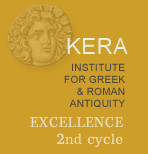Main Site . Other insciptions from the main site of Boubon
28. Honorary inscription for a (deceased?) female citizen
![]()
5 10 |
[Βουβωνέων? ἡ βουλὴ [καὶ ὁ δῆμος? ἐτείμη-] σεν ται̣[ς ἀξίαις? τει]– μαῖς Λ[ ̣– – – – –– – – – –] τοῦ Κο[– – – – – Βουβω]– νίδα γυ[ναῖκα ζήσασαν] σωφρόν[ως καὶ σεμνῶς] πάσῃ ἀ[ρετῇ κεκοσμη]– μένην ἱε[ρασαμένην] τῶν θε[ῶν Σεβαστῶν?] εὐσεβῶ[ς μετὰ τοῦ ἀν]– δρὸς αὐ[τῆς – – – – – – ] τοῦ Νεά[ρχου ̣– – – – – ] καὶ πολ[λὰ καὶ μεγάλα ἀ]– ναλώσ̣[ασαν τῇ πατρίδι] |
[The council and the people of Boubon?] honored [with the deserved?] honors [-------], of Ko[---] citizen of Boubon, a woman [who led a] prudent and [noble life], adorned with every virtue, who exercised the office of priestess of the [emperors?] with piety, [together with] her husband Nearchos [------] and bore many [great] expenses [for the city].
Fragment preserving the left part of a block found in Boubon (no further specification) by Bean and Schindler in 1966.
Height: 93 cm; length: 33 cm; depth: 30 cm; letters: 3 cm.
Schindler 1972, no. 10 (pl. 2.10: photograph); Milner 1998, p. 2, no. 1.23; BullÉp 1973, no. 455.
L. 5 : Possibly Κόμωνος (Κόμων) as in no. 58, or Κόνωνος (Κόνων). The name Κόμων is attested in an inscription from Cibyra (IGR IV 927 cf. Naour 1980, p. 13 with n. 44) and a few times in inscriptions from Pisidia, i.a. IK Selge 22; MAMA 8 394; Ramsay (1897), p. 338, no. 180; p. 339, no. 189; SEG 2 (1925), no. 717. Less likely, we might be dealing with the rare name Kόννος, attested once in Kibyra (IK Kibyra I 235).
L. 13. Νέαρχος also attested in nos. 23, 26 and 48. In the first two cases the name belongs, again, to persons who had been priests of the imperial cult. It may have been popular among the members of a family that traditionally undertook this office. It is a common Greek name, attested 6 times in Cibyra (IK Kibyra I 49; 162; 217; 262; 279; 288).
Robert (op. cit.) holds that Schindler's calculation of the lacuna on the right side is inaccurate, and that the lines were longer, because γυ[ναῖκα would be followed by some specification (indicating the husband) or adjective (he suggests εὐγενίδα). The critique seems misplaced, because a specification seems more likely to have been given on the preceding lines, and ζήσασα σωφρόνως is as good as an adjective. Moreover, the length of the lines can be established on the basis of more than one fairly secure restoration in ll. 8, 9, 11 and 14. Also the restoration of Σεβαστῶν in line 10 is, in my opinion, reasonably secure, though Schindler chose to refer to this possibility only in his commentary.

